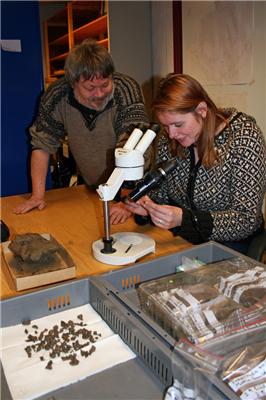Dec 28 2009
When archaeologist Ruth Iren Øien noticed a cluster of tiny iron beads in the ground, she knew she was onto something. She did not know, however, that her team had stumbled upon Scandinavia's oldest and most complex group of iron forges.
 ”Preben Rønne and Ruth Iren Øien at the artifact storage room, looking at the material from the forges.” Photo: Tove Eivindsen/NTNU Museum.
”Preben Rønne and Ruth Iren Øien at the artifact storage room, looking at the material from the forges.” Photo: Tove Eivindsen/NTNU Museum.
And not only that, it would be months before Øien, with the Norwegian University of Science and Technology's Museum of Natural History and Archaeology, would discover the actual significance of her find.
The iron beads were first found in November 2008, right at the very end of a highly weather-dependent field season in Norway. With frost about to set in, further investigation had to wait until the summer of 2009. But in July, Øien's team returned to the site.
The iron beads that had piqued Øien's interest were only 1 to1.5 millimetres in diameter. But they were sufficient to make her realize they might be residue from a smithy. It turned out she was right, but the number of forges on the small field surprised everyone.
"We found three different types of forges", Øien says. "Some were small and circular, some were indoors, and a third type was in the shape of a figure eight. Findings suggest the smiths used one half of the figure-eight shaped forges for the rough work before refining the iron in the other forges."
The excavations uncovered more than 200 construction-related artefacts, including post holes, forges, fireplaces and wall ditches. "Even though we have only uncovered half of the area, we have already found seven forges", says Preben Rønne, the museum's project manager for the site. "This cluster suggest some kind of early industrial activity, in the sense that clearly they had large scale production."
"These are rare and exciting results, and unique in a Scandinavian context", he adds.
The forges were found at Forsetmoen, a rural area about 1.5 hours south of Trondheim, Norway. The scientists believe the location is anything but coincidental.
"The iron was produced in the smaller side valleys, and transported to Forsetmoen for refining. From there iron artefacts have been transported to the larger farms further out. Maybe they've been sold even further", Rønne says.
The forges have been dated to 0-500 AD. and the various building artefacts to 400-500 AD.
The team also found post holes from a large house that was at least 30 metres long. One end seems to have been used for working the iron, with remains of elevated forges, an airing canal and a possible foundation for an ambolt. The large quantities of burnt bark that they found could be from a roof, and suggest the forge might have burnt down.
The finds are the first tantalizing clues that give an answer to the archaeological mystery of where and how Iron Age Scandinavians refined their iron.